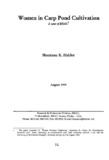| dc.description.abstract | This is a case study on 106 female fishermen who made success in increasing their
household income with the help of BRAC provided services. Fish cultivation was
found to be highly correlated with many factors such as types of soil in the ponds,
ownership of ponds, their size and position, farmers' occupation, education, marital
status, their skill on fish cultivation and the intensity of labour to be employed in the
activities. In majority cases their involvement in the given activity increased household
income which helped further expansion of the business, in reducing their dependency
on their male income earners, and finally it helped increase household's fish
consumption. The cost of BRAC provided services was Tk. 335.75 against Tk. 201.45
charged by BRAC. The net income earned by each member-farmer was 56.6 times
higher than those of the additional amount spent by BRAC per member-farmer. To
make the programme cost-effective it should involve the marginal farmers and give
them training on the use of advanced technology. The exist-ing loan repayment system
may be changed. A major amount may be collected at the time of harvesting. It will
help reduce the pressure on farmers. Thus, they will be able to spend higher
proportion of loan for fish cultivation. Demonstration ponds may be introduced. The
number of field staff may be increased for better service delivery and to reduce existing
workload. • although soil type does not always matter for mixed fish cultivation, the sandy
loam, clay-loam and loam soil are considered to be better suited for it.
Carp polyculture is also done in derelict ponds. BRAC leases in derelict ponds from
their owners for a maximum period of 10 years, re-excavates them and then, leases it
out to its VO members. Lease value per decimal of pond depends on the cost of reexcavation.
Money charged for leasing out the ponds is deposited in the VO account of
those members who lease in the ponds and use them for the maintenance of ponds.
BRAC selects those members for fish cultivation who are very keen to do it, own
ponds or can lease them, preferably have previous experiences and willing to
participate in BRAC fisheries training session. Farmers and ponds selection are done in
February-March. Selected farmers are given training any time during March-May. The
preparation of ponds and stocking of fingerlings are done in April-June. Fish is
harvested during August-June.
In each decimal of pond around 34 fingerlings of different carp species are released
consisting of 10-12 silver carp, 4-6 katla, 6-7 rui, 5-7 mrigal, 2 mirror carp and 2-3 grass
carp. A member-farmer receives Tk 175-200 as loan per decimal of water body from
BRAC which covers all the cost of production including the lease value (RDP
Operation Manual, 1995). | en_US |

